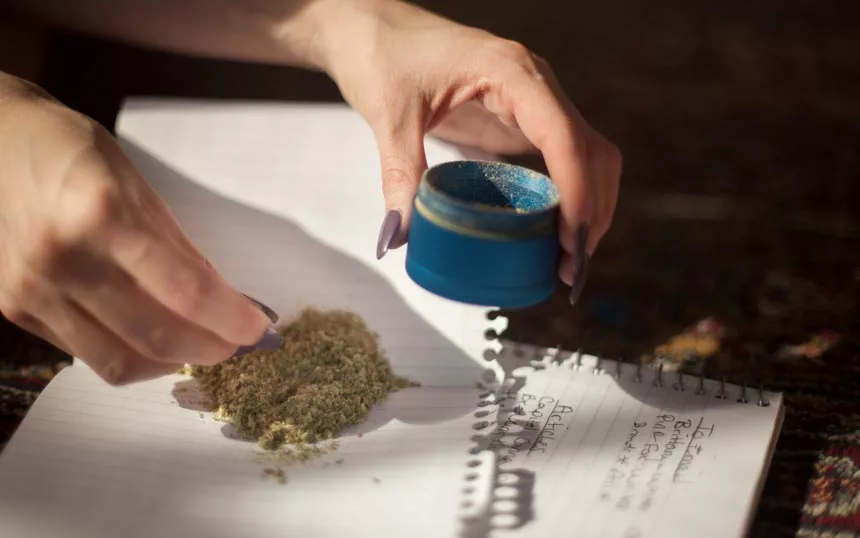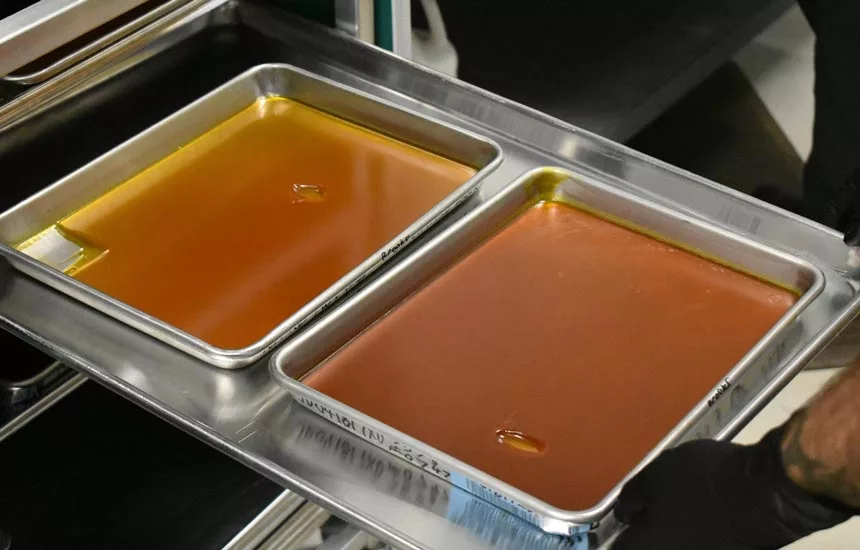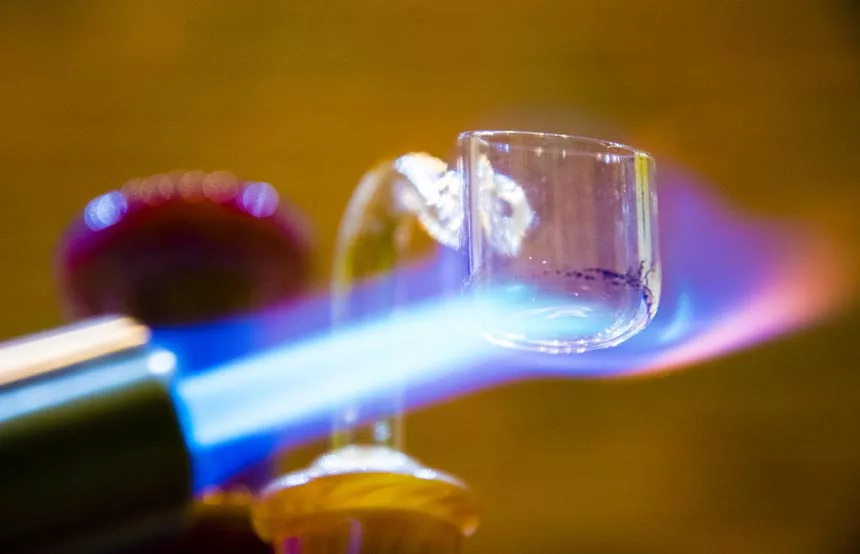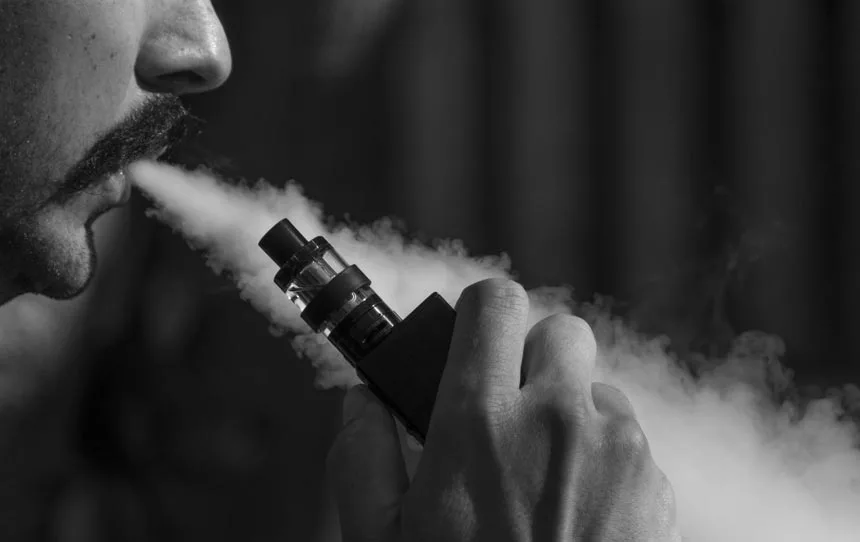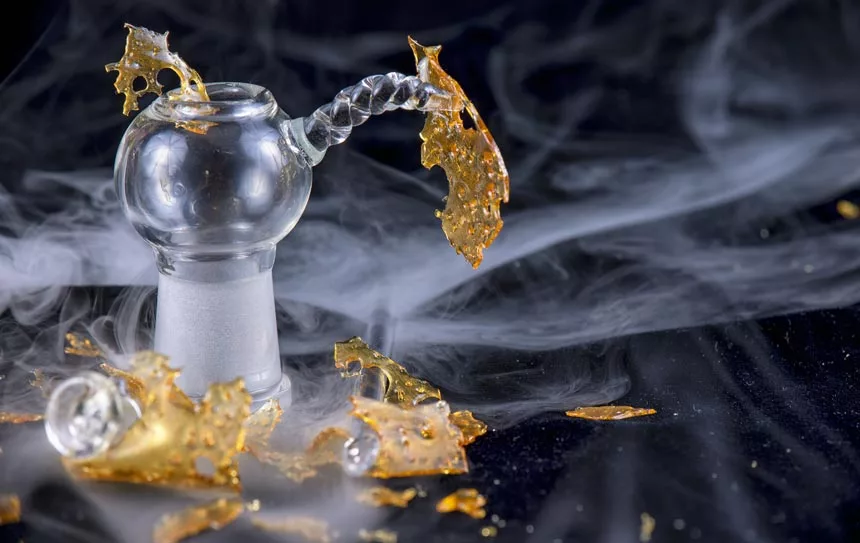The Scoop on Shatter
Table of Contents
- The Scoop on Shatter
- What Are Cannabis Concentrates?
- What Is Shatter?
- How Is Cannabis Shatter Made?
- Is Shatter Different From Other Cannabis Extracts?
- What is Shatter: How Do People Use It?
- The Dangers Of Illegal And Homemade Shatter
- The Shatter Drug: Use Dangers And Side Effects
- Can Shatter Be Addictive: Dependency Risks
- Who Is at Risk Of Shatter Drug Addiction?
- Marijuana Shatter Withdrawal Symptoms
- Using Cannabis Concentrates Without Danger or Addiction
- Shattering The Habit: Tips to Reign It In
- Shatter Dependency for Good!
- Medically Reviewed By
Shatter is one of the most popular cannabis concentrates around. While its recreational and medicinal use is legal in certain states, it’s not risk-free. Like anything, this golden, glass-like substance has potential pitfalls.
Growing quick-yielding and potent strains like Amnesia autoflower was once the only way to get a heavy dose of tetrahydrocannabinol (THC), the psychoactive compound in weed.
That’s changed. Nowadays, marijuana extracts with extremely high levels of THC or cannabidiol (CBD) are widely available. One, in particular, is known as shatter, though it’s often confused with “honey oil,” “dab wax,” “badder,” “budder,” or “crumble.”
What is shatter, anyway? Is it dangerous? What are the side effects?
Below you’ll find answers to these questions and more, including how it’s made and consumed, the dependency risks, and withdrawal symptoms. We’ll also cover weed derivatives, using them without addiction, and tips to shatter the habit.
Ready? Let’s get into it.
What Are Cannabis Concentrates?
A female marijuana plant bears flowers covered in trichomes. The glittering, resin-producing glands contain cannabinoids, flavonoids, terpenes, and other compounds. These phytochemicals are responsible for weed’s flavors, aromas, and effects.
Cannabis concentrates are an accumulation of trichomes condensed into a mass or substance, like wax, rosin, honey oil, hash, or shatter (sometimes called “dabs.”)
The process involves drawing out the resin, removing excess plant material, and refining weed into its purest possible form.
Types Of Marijuana Concentrates
Some extracts include all cannabinoids, flavonoids, and terpenes, while others contain a single purified compound. The former includes full or broad-spectrum concentrates like distillates or live resin, with the various compounds working in synergy to create the entourage effect.
The latter are called isolates, extremely potent (nearing 100%) concentrations of a specific cannabis compound like THC or CBD.
Both types are popular among medical marijuana patients and recreational users. That said, many people believe full-spectrum varieties have greater medicinal value than isolates.
These weed derivatives come in various forms, depending on the extraction method, texture, and consistency. They include:
- Kief: An extract derived from loose trichomes accumulated by sifting cannabis flower through a sieve or mesh screen.
- Hash: An ancient marijuana concentrate made from kief that’s usually brown, dark green, or amber-colored. It comes in a dense ball or brick.
- Rosin: A full-spectrum, solventless extract derived from cannabis buds, hash, or kief with a malleable consistency when cool.
- Butane hash oil (BHO): Generally refers to any weed concentrate made with butane-based extraction methods.
- Oils: Full-spectrum or isolated cannabis extracts with a honey-like consistency ranging from yellow to dark brown.
- Wax concentrates: Derivatives whipped up during production to change the consistency from dense and stiff to soft and malleable.
- Sugar wax: A solvent-based extract with a shiny, sticky appearance resembling brown sugar.
- Budder, butter, or badder wax: A fluffier, creamier wax-like concentrate that looks like cake batter or butter, varying in color from light yellow to brown.
- Crystalline, diamonds, or wizard stones: Isolated and crystallized THC or CBD resembling tiny quartz crystals with no flavors or aromas and a translucent to cloudy appearance.
- Honeycomb or crumble: A more brittle version of budder with a crumbly texture and light to dark yellow coloring.
- Shatter: A hard, thin, and translucent BHO extract.
Common Cannabis Plant Extraction Methods
Cannabis concentrates are typically made through either solventless or solvent-based techniques, though research on alternative methods for medicinal weed is ongoing.
Solventless extraction refers to a physical or mechanical process using temperature, pressure, or agitation, such as:
- Dry-sieving: Produces kief or hash.
- Heat and pressure extraction: Used to make rosin or oils.
- Water extraction: Churns out bubble hash or ice water hash.
Conversely, solvent-based extraction relies on chemical or organic substances to create cannabis extracts. These include:
- Isopropyl alcohol: Ideal for making THC or CBD oil.
- Supercritical CO2: Used to produce marijuana waxes and oils.
- Butane gas: Makes derivatives like butane hash oil.
Cannabis Plant Extracts vs. Concentrates
Although used interchangeably, marijuana concentrates and extracts have subtle differences. Extracts are types of concentrates made using solvent-based methods. Meanwhile, solventless varieties are simply called concentrates.
In other words, all extracts are concentrates, but not all concentrates are extracts.
Due to their varying textures, some cannabis derivatives can be hard to differentiate from others. That’s not the case with shatter, though.
What Is Shatter?
Shatter is a relatively new drug or cannabis extract, also known as dabs, shatter wax, glass, marijuana shatter, or shatter weed.
It first garnered attention in the early 2010s, though its history reportedly dates back to the late 1990s.
That’s when Canadian cannabis grower BudderKing originally developed shatter (as the story goes).
By 2005, the production process was made public in Cannabis Culture magazine, and a few years later, shatter’s popularity exploded. Today, it features in many dispensaries across the country.
So, what is shatter?
It’s an extremely potent marijuana extract derived from butane hash oil.
While not usually classified as an isolate, cannabis shatter still has high levels of THC, averaging between 50–80%.
In some cases, it can even test upward of 90% THC, compared to dried marijuana buds which seldom have more than 30% THC.
The potency depends on a few factors, including the quality and chemical composition of the source plant material and the production process.
Like hard candy, this BHO concentrate is brittle with a translucent, glass-like appearance. It’s typically honey-colored and cracks or shatters when broken.
What Is CBD Shatter?
CBD shatter is a type of CBD isolate containing no other plant material or compounds.
Manufacturers typically make it by first extracting a full-spectrum concentrate and filtering it through processes like winterization. Eventually, all unwanted compounds are removed, leaving nothing but high levels of CBD.
In some cases, terpenes are added back into the isolate, creating a broad-spectrum extract.
Medical marijuana patients use CBD shatter for various reasons. Without any THC, it doesn’t usually have psychoactive properties or side effects.
How Is Cannabis Shatter Made?
Like other cannabis extracts, shatter is made via an extraction method where the desired compounds are separated from the unwanted plant matter.
A liquid solvent (typically butane gas) is poured over a dried marijuana bud before being gently purged with heat to avoid combustion. Once cooled, the leftover concentrate is thin, brittle, and translucent.
Since the solvent is flammable and the technique requires heat, precision, and expertise, making shatter is extremely dangerous and should be left to professionals. It may also be illegal in certain jurisdictions.
Is Shatter Different From Other Cannabis Extracts?
In the practical sense, shatter, and other cannabis extracts are much the same. The production processes are alike, and the consumption methods are similar.
Shatter weed is considered one of the purest marijuana concentrates. Its other defining features are its texture and clear, glass-like appearance.
These cosmetic differences lie in initial extraction, where the shatter’s molecular structure remains undisturbed. Other weed derivatives are shaken, stirred, or whipped, agitating the molecules, which results in a lighter, wax-like texture and cloudy appearance.
Heat, moisture, and chemical composition also affect an extract’s texture and consistency.
What is Shatter: How Do People Use It?
Most cannabis consumers vape or dab shatter, though it can also be used in edibles.
The former involves flash vaporization through a specialized vape pen. Shatter wax is placed inside the heating chamber, causing it to melt and turn to vapor, which is then inhaled via a mouthpiece.
The latter is a more traditional way of using shatter, so it’s often called “dabs.” The term refers to any cannabis extract consumed with a pipe called a dab rig.
A piece of shatter is placed or “dabbed” onto a small hot surface like a ceramic nail. As it rapidly heats up, the resulting vapor is inhaled through the dab rig’s water chamber.
Many recreational and medical marijuana users prefer these methods since they’re convenient, fast-acting, and discreet. Still, shatter can be dangerous, especially if it’s not from an official source like a legal dispensary.
The Dangers Of Illegal And Homemade Shatter
An illegally distributed shatter drug often comes from makeshift labs, where production isn’t regulated or controlled.
The extraction process alone is extremely dangerous. One tiny misjudgment can lead to a deadly explosion, but that’s not the only risk.
The solvent used to make shatter, butane gas, is volatile, highly flammable, and toxic.
If done haphazardly without painstaking precision, improper extraction produces a cannabis concentrate with excess butane. Inhaling too much poses numerous health risks, including:
- Hallucinations
- Convulsions
- Respiratory problems
- Organ failure
- Cardiac damage
- Liver problems
While regulated and legitimate dispensaries mitigate these fears, amateur BHO practices are still on the rise in weed-legalized states.
One study found an increase in flash and hydrocarbon burns, coinciding with more makeshift labs in these jurisdictions.
In short, making shatter at home or getting it illegally can be fatal.
The Shatter Drug: Use Dangers And Side Effects
Besides production risks, using cannabis shatter poses other health dangers. The research is lacking, but some studies suggest long-term dabbing can cause lung injury. Vaping isn’t entirely safe, either, though it’s less harmful than smoking.
The remaining dangers of using shatter involve its effects.
Unlike other forms of cannabis, extracts are incredibly potent, making them inherently riskier to use. They’re also fast-acting, and intense effects may manifest quickly.
Due to shatter’s high levels of THC, some people could have negative experiences.
While THC may have purported medicinal and therapeutic effects, abuse or overconsumption can still cause adverse side effects.
A lethal overdose is unlikely, according to the Centers for Disease Control (CDC). Still, drug-induced psychosis can occur in extreme cases. Other possible side effects include:
- Anxiety
- Paranoia
- Reduced coordination
- Brain fog
- Loss of concentration
- “Wet brain” or the reduced ability to recall information
- Insomnia
- Increased heart rate and blood pressure
- A weakened immune system
- Bloodshot eyes
- Airway spasms and narrowing
- Sinus and lung infections
Physical dependency may also be a risk, like anything that’s regularly used or consumed.
Can Shatter Be Addictive: Dependency Risks
Just as marijuana can be addictive, so can shatter weed. Not everyone reacts the same way to cannabis or its compounds. The effects may manifest differently, depending on factors like:
- THC tolerance
- Consumption method
- Whether it’s ingested with other substances
- Genetic makeup
- Use frequency
The above can contribute to physical or psychological dependency, especially with highly potent weed extracts like shatter.
Who Is at Risk Of Shatter Drug Addiction?
Research suggests that teenagers are more vulnerable to weed addiction than adults, but substance abuse disorders can affect anyone.
Even casual cannabis consumers may find themselves physically or psychologically dependent on marijuana or extracts like shatter.
Some contributing factors out of your control may also increase dependency risks, such as:
- Substance abuse in the family
- Traumatic childhood experiences
- Mental health challenges
Peer pressure and the lack of a support structure are also possible contributors, along with physical dependency due to medical conditions.
Help is available, and treatment is possible to overcome shatter drug addiction or dependency.
Marijuana Shatter Withdrawal Symptoms
Some people may unwittingly find themselves psychologically dependent on cannabis or extracts like shatter wax. This can lead to tolerance, which, in turn, could result in higher consumption.
Feelings of being unable to control the urge to consume weed or shatter is a sign of dependency. Possible withdrawal symptoms of cannabis concentrates include:
- Irritability and confusion
- Heightened anxiety
- Trouble falling or staying asleep
- Increased stress and nervousness
Like other cannabis extracts, using shatter heavily can cause the brain to reduce anandamide production.
As such, the brain’s signaling network could be negatively affected. It’s linked to the endocannabinoid system and plays a central role in the nervous system. Severe side effects could include memory and cognitive impairment.
According to the American Heart Association (ASA), neuroimaging research shows structural changes in the brains of cannabis consumers, though the results are inconsistent.
Using Cannabis Concentrates Without Danger or Addiction
Attempting to make your own shatter at home or getting it from a “backyard” chemist is incredibly dangerous and may be unlawful.
Only buy marijuana concentrates from legal dispensaries to ensure your safety and abide by the law. You’ll also have better control over the dosage.
If you’re a casual cannabis consumer concerned about weed extract use, monitor your intake and cut down slowly. A healthy, balanced lifestyle is vital, along with effective stress management.
Enough sleep, a good diet, and regular mental health checks are crucial too.
If you’re worried about becoming dependent on shatter wax or other marijuana extracts, there are various ways to reign in your consumption.
Shattering The Habit: Tips to Reign It In
Do you find yourself craving cannabis concentrates? Try taking some of the following practical steps:
Change Consumption Methods
Shatter can be up to five times more potent than conventional cannabis flower or bud. By changing consumption methods, you could significantly reduce your THC intake.
It may prove easier to stay on top of your THC tolerance and lower the amount of weed you consume. Adjusting can be tricky at first, so be mindful of your intake.
Limit Your Intake
Alternatively, cut down on how often you use marijuana concentrates like shatter. You can reduce your intake gradually or consider going cold turkey. During this process, you may experience some withdrawal symptoms discussed earlier.
While they may be manageable, it’s always a good idea to have support from friends, family, or experts.
Get Professional Help
If you’re seeing signs of shatter addiction and don’t know how to quit marijuana, it’s best to enlist professional help. Experts can give you the tools you need to overcome this challenge while addressing the root causes.
Cognitive Behavioral Therapy (CBT)
CBT is a psychotherapeutic method that focuses on modifying negative thinking patterns to overcome destructive habits and behaviors. It also helps address the underlying causes of the issue.
Motivational Enhancement Therapy (MET)
MET is designed to help patients understand their dependency or addiction and nurture inner motivation. It encourages goal-setting and inner strength to map out a path to successful recovery.
Contingency Management
This approach uses positive reinforcement to help patients embrace beneficial thinking habits and alter the thinking patterns that led to addiction.
Shatter Dependency for Good!
Shatter is a highly potent marijuana extract usually derived from butane hash oil. It’s dangerous to make yourself and risky to get from any source other than a legitimate dispensary.
Burns and explosions are common in at-home BHO setups, and makeshift labs are often illegal and unregulated.
Street shatter drugs can also be toxic with excess butane gas and other impurities.
While it’s a popular cannabis concentrate with purported therapeutic properties, shatter has other risks too.
The effects vary from person to person, but some people may have negative experiences. The possible side effects include anxiety, overwhelming paranoia, and in extreme cases, drug-induced psychosis.
Physical dependency is also an inherent risk.
If you think you or a loved one might be struggling with shatter addiction or cannabis dependency, reach out.
Get the help you need right now and call Find Addiction Rehabs today!

